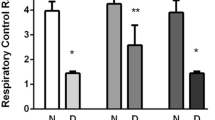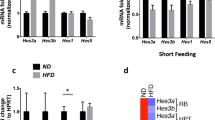Abstract
Brain–pancreas relative protein (BPRP) is a novel protein that mainly expresses in brain and pancreas. In our previous study, we found that various stressors significantly decreased the expression of BPRP in pancreas in vivo, accompanied by changes in insulin and glucose levels, and that expression of BPRP in pancreas also decreased significantly in diabetic rats induced by Streptozocin (STZ). All these findings suggest that BPRP may be a glucose or insulin-sensitive protein. However, how the changes in insulin or glucose levels influence the expression of BPRP in hippocampus requires further study. Here, we investigated the effects of insulin or glucose on the expression of BPRP in primary cultured hippocampal neurons. We supplied hippocampal neurons with glucose, insulin, or supernatant from pancreatic β-cells, which secrete insulin into the supernatant. Our data showed that insulin had beneficial effect on the viability while no significant effect on the expression of BPRP in hippocampal neurons. On the contrary, 40 mM glucose or free glucose culture significantly decreased the expression of BPRP, while had no significant effect on the viability and apoptosis of hippocampal neurons. Further study showed that levels of insulin in the supernatant collected from pancreatic β-cells medium changed over days, and that supernatant increased the viability of hippocampal neurons, while it had no obvious effect on the expression of BPRP in hippocampal neurons. These results suggest that BPRP may be a glucose-sensitive protein.





Similar content being viewed by others
References
Yao XH, Yu HM, Koide SS, Li XJ (2003) Identification of a key protein associated with cerebral ischemia. Brain Res 967:11–18
Lin YH, Liu AH, Xu Y, Tie L, Yu HM, Li XJ (2005) Effect of chronic unpredictable mild stress on brain–pancreas relative protein in rat brain and pancreas. Behav Brain Res 165:63–71
Biessels GJ, Kapella AC, Bravenboer B, Erkelens DW, Gispen WH (1994) Cerebral function in diabetes mellitus. Diabetologia 37:643–650
Margolis RU, Altszuler N (1967) Insulin in the cerebrospinal fluid. Nature 215:1375–1376
Woods SC, Porte DJ (1977) Relationship between plasma and cerebrospinal fluid insulin levels of dogs. Am J Physiol 233:E331–E334
Szabo O, Szabo AJ (1972) Evidence for an insulin sensitive receptor in the central nervous system. Am J Physiol 223:1349–1353
Storlien L, Bellingham WP, Martin GM (1975) Localization of CNS glucoregulatory insulin receptors within the ventromedial hypothalamus. Brain Res 96:156–160
Dorn A, Bernstein HG, Hahn HJ, Ziegler M, Rummelfanger H (1981) Insulin immunohistochemistry of rodent CNS: apparent species differences but good correlation with radioimmunological data. Histochem 71:609–616
Zhao WQ, Chen H, Quon MJ, Alkon DL (2004) Insulin and the insulin receptor in experimental models of learning and memory. Eur J Pharmacol 490:71–81
Singh P, Jain A, Kaur G (2004) Impact of hypoglycemia and diabetes on CNS: correlation of mitochondrial oxidative stress with DNA damage. Mol Cell Biochem 260:153–159
Auer RN (2004) Hypoglycemic brain damage. Metab Brain Dis 19:169–175
Auer RN, Kalimo H, Olsson Y, Wieloch T (1985) The dentate gyrus in hypoglycemia. Pathology implicating excitotoxin-mediated neuronal necrosis. Acta Neuropathol 67:279–288
Bestetti G, Rossi GL (1980) Hypothalamic lesions in rats with long-term streptozotocin-induced diabetes mellitus. A semiquantitative light-and electron -microscopic study. Acta Neuropathol 52:119–127
Bestetti G, Rossi GL (1982) Hypothalamic changes in diabetic Chinese hamsters. A semiquantitative, light and electron microscopic study. Lab Invest 47:516–522
Garris DR, Diani AR, Smith C, Gerritsen GC (1982) Depopulation of the ventromedial hypothalamic nucleus in the diabetic Chinese hamster. Acta Neuropathol 56:63–66
Luse SA (1970) The ultrastructure of the brain in the diabetic Chinese hamster with special reference to synaptic abnormalities. Electroencephalogr Clin Neurophysiol 29:410
Mukai N, Hori S, Pomeroy M (1980) Cerebral lesions in rats with streptozotoci- induced diabetes. Acta Neuropathol 51:79–84
Herbert V, Lau KS, Gottlieb CW, Bleicher SJ (1965) Coated charcoal immunoassay of insulin. J Clin Endocrinol Metab 25:1375–1384
Gasparini L, Netzer WJ, Greengard P, Xu H (2002) Does insulin dysfunction play a role in Alzheimer’s disease? Trends Pharmacol Sci 23:288–293
Snyder EY, Kim SV (1980) Insulin: is it a nerve survival factor? Brain Res 196:565–574
Baskin DG, Porte D Jr, Guest K, Dorsa DM (1983) Regional concentrations of insulin in the rat brain. Endocrinology 112:898–903
Schulingkamp RJ, Pagano TC, Hung D, Raffa RB (2000) Insulin receptors and insulin action in the brain: review and clinical implications. Neurosci Biobehav Rev 24:855–872
Unger JW, Livingston JN, Moss AM (1991) Insulin receptors in the central nervous system: localization, signalling mechanisms and functional aspects. Prog Neurobiol 36:343–362
Schechter R, Sadiq HF, Devaskar SU (1990) Insulin and insulin mRNA are detected in neuronal cell cultures maintained in an insulin-free/serum-free medium. J Histochem Cytochem 38:829–836
Zhao WQ, Chen H, Xu H, Moore E, Meiri N, Quon MJ, Alkon DC (1999) Brain insulin receptors and spatial memory. J Biol Chem 274:34893–34902
Moxham CP, Duronio V, Jacobs S (1989) Insulin-like growth factor I receptor beta-subunit heterogeneity. Evidence for hybrid tetramers composed of insulin-like growth factor I and insulin receptor heterodimers. J Biol Chem 264:13238–13244
Jonas E, Knox RJ, Smith TC, Wayne NL, Connor JA, Kaczmarek LK (1997) Regulation by insulin of a unique neuronal Ca2+ pool and of neuropeptide secretion. Nature 385:343–346
Recio-Pinto E, Lang FF, Ishii DN (1984) Insulin and insulin-like growth factor II permit nerve growth factor binding and the neurit formation response in cultured human neuroblastoma cells. Proc Natl Acad Sci USA 81:2562–2566
Wan Q, Xiong ZG, Man HY, Ackerley CA, Braunton J, Lu WY, Becker LE, MacDonald JF, Wang YT (1997) Recruitment of functional GABA(A) receptors to postsynaptic domains by insulin. Nature 388:686–690
Zheng WH, Kar S, Quirion R (2002) Insulin-like growth factor-1-induced phosphorylation of transcription factor FKHRL1 is mediated by phosphatidylinositol 3-kinase/Akt kinase and role of this pathway in insulin-like growth factor-1-induced survival of cultured hippocampal neurons. Mol Pharmacol 62:225–233
Hooghe-Peters EL, Meda P, Orci L (1981) Co-culture of nerve cells and pancreatic islets. Brain Res 227:287–292
Magarinos AM, Jain K, Blount ED, Reagan L, Smith BH, McEwen BS (2001) Peritoneal implantation of macroencapsulated porcine pancreatic islets in diabetic rats ameliorates severe hyperglycemia and prevents retraction and simplification of hippocampal dendrites. Brain Res 902:282–287
McNay EC, Fries TM, Gold PE (2000) Decreases in rat extracellular hippocampal glucose concentration associated with cognitive demand during a spatial task. Proc Natl Acad Sci USA 97:2881–2885
McNay EC, McCarthy RC, Gold PE (2001) Fluctuations in brain glucose concentration during behavioral testing: dissociations between brain areas and between brain and blood. Neurobiol Learn Mem 75:325–337
Wozniak M, Rydzewski B, Baker SP, Raizada MK (1993) The cellular and physiological actions of insulin in the central nervous system. Neurochem Int 22:1–10
Henneberg N, Hoyer S (1995) Desensitization of the neuronal insulin receptor: a new approach in the etiopathogenesis of late-onset sporadic dementia of the Alzheimer type (SDAT)? Arch Gerontol Geriatr 21:63–74
Hoyer S, Prem L, Sorbi S, Amaducci L (1993) Stimulation of glycolytic key enzymes in cerebral cortex by insulin. Neuro Rep 4:991–993
Wree A (1991) Local cerebral glucose utilization in the brain of old learning impaired rats. Histochemistry 95:591–603
Acknowledgments
This work was supported by a grant from the National Nature Science Foundation of China (No. 30270528), 973-Program of the Ministry of Science and Technology, and Research Funds from Ministry of Education of China, No. 20020001082 and 985 and 211 Projects.
Author information
Authors and Affiliations
Corresponding author
Rights and permissions
About this article
Cite this article
Lin, YH., Westenbroek, C., Tie, L. et al. Effects of Glucose, Insulin, and Supernatant from Pancreatic β-cells on Brain–Pancreas Relative Protein in Rat Hippocampus. Neurochem Res 31, 1417–1424 (2006). https://doi.org/10.1007/s11064-006-9193-9
Received:
Accepted:
Published:
Issue Date:
DOI: https://doi.org/10.1007/s11064-006-9193-9




